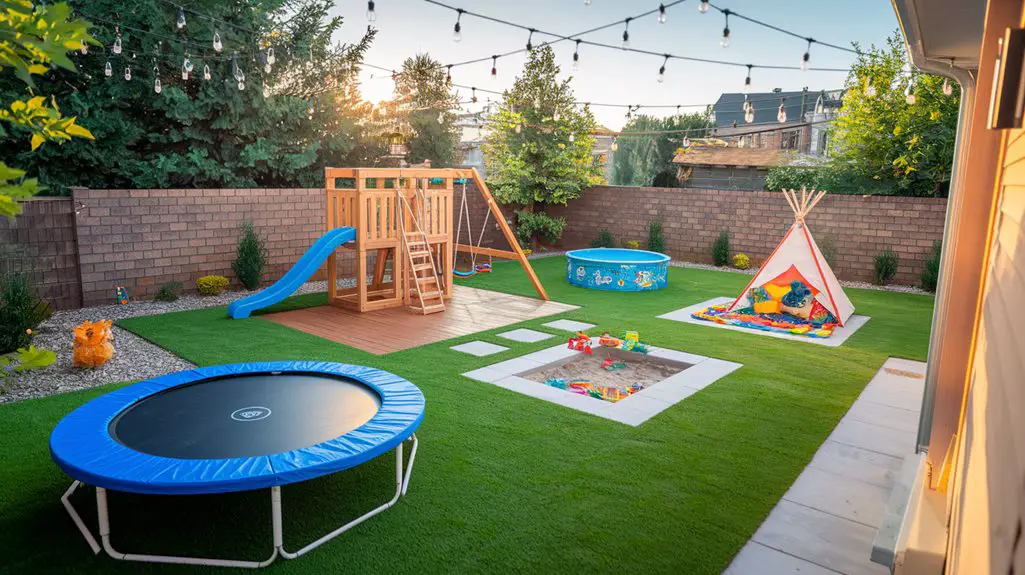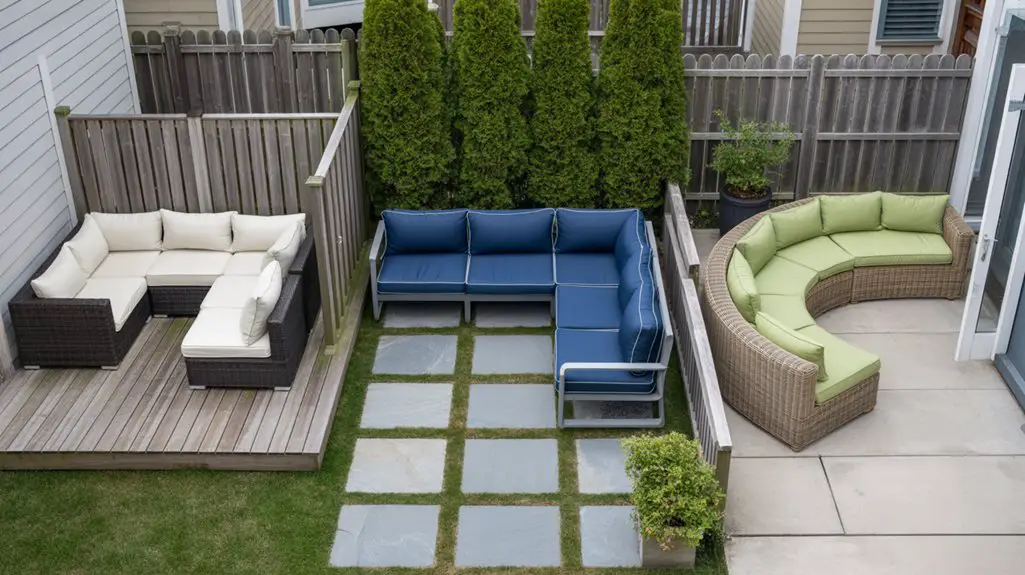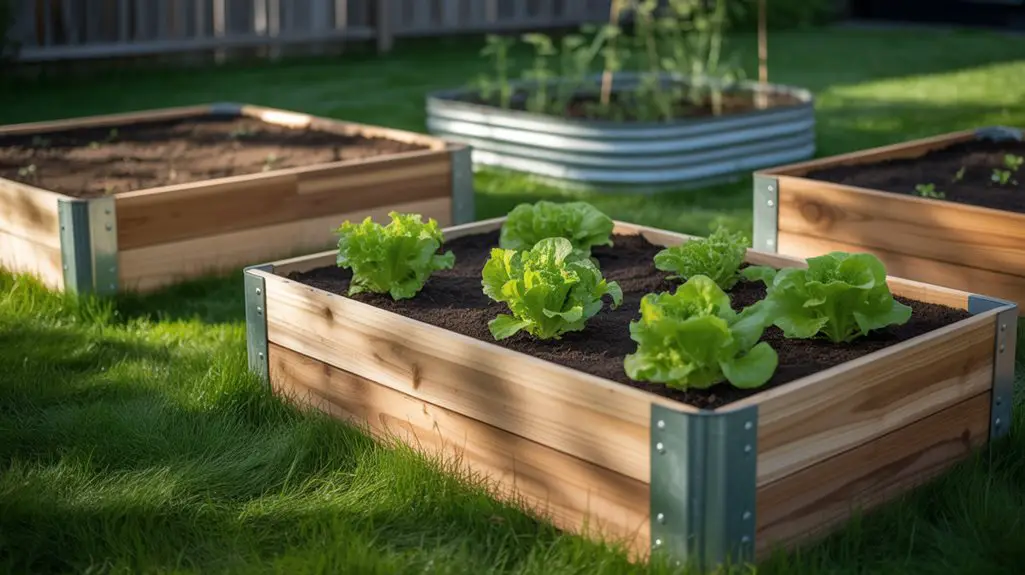Your backyard stands as both a canvas and fortress—a space where childhood memories take root while safety remains paramount. You’ll discover that creating dedicated play zones doesn’t require sacrificing fun for protection; rather, they complement each other perfectly. From cushioned landing surfaces to sensory-rich exploration stations, thoughtful design transforms ordinary spaces into extraordinary adventures. The following ideas merge developmental benefits with practical safety measures in ways you might not have considered.
Creating a Soft-Surface Playground With Natural Materials
When designing a backyard play area for children, prioritizing softscape materials creates both a safer environment and enriched sensory experiences.
Consider using engineered wood fiber mulch, which absorbs impact effectively while remaining wheelchair accessible at proper depths of 8-12 inches.
Sand offers excellent cushioning properties when installed at 12-inch depths, though you’ll need adequate drainage and regular maintenance to prevent compaction.
For toddler zones, pea gravel (rounded, not crushed) provides tactile stimulation while cushioning minor falls.
Natural grass remains cost-effective but requires routine maintenance to prevent bare spots that compromise safety.
Consider integrating rubber mulch around high-impact zones beneath swings and slides, as research indicates it reduces injury severity by up to 40% compared to traditional surfaces.
Additionally, implementing safety measures such as regular inspections of the play area can help ensure that potential hazards are identified and addressed promptly.
Installing Weather-Resistant Play Equipment for All Ages
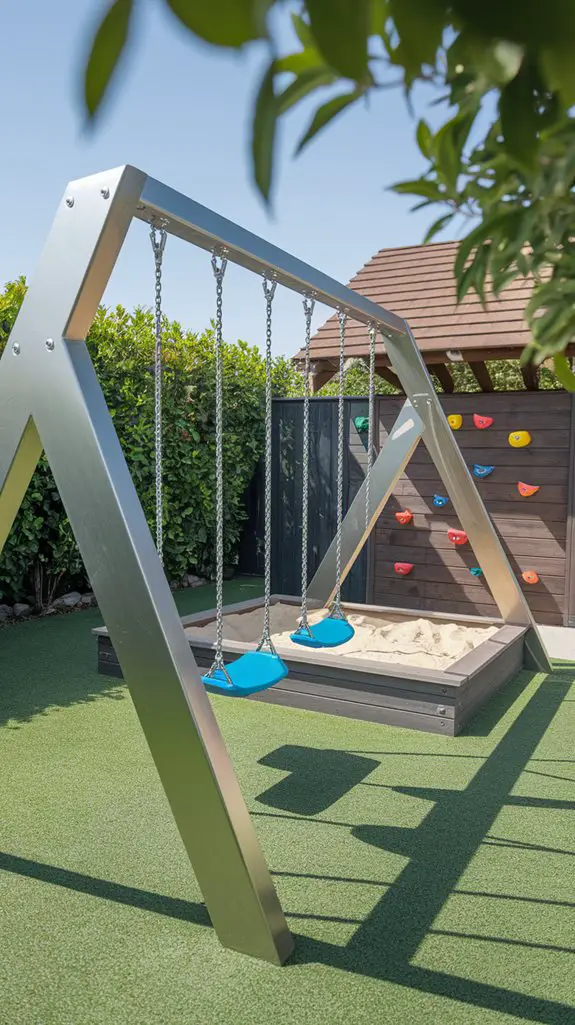
With a soft, impact-absorbing surface established, you’ll need durable play equipment that withstands environmental challenges while engaging children throughout their developmental stages. Select materials rated for outdoor use—powder-coated steel, cedar, or UV-stabilized plastic—to guarantee longevity and safety. Additionally, incorporating a variety of play zones ensures that children remain active and engaged in different ways.
| Age Group | Recommended Equipment | Weather Considerations |
|---|---|---|
| Toddlers (1-3) | Low slides, sensory panels | Shade essential, no metal surfaces |
| Preschool (3-5) | Climbing structures, swings | Weather-treated wood, rounded edges |
| Early Elementary (5-8) | Monkey bars, rope ladders | Rust-resistant hardware, annual sealing |
| Middle Elementary (8-10) | Balance beams, ziplines | Wind-rated installations, secure anchoring |
| Tweens (10-12) | Challenge courses, climbing walls | Regular structural inspections, reinforced joints |
Position equipment with adequate fall zones—minimum 6 feet surrounding structures—and guarantee proper drainage to prevent water accumulation that accelerates deterioration and creates hazards.
Designing a Secure Water Play Area That Conserves Resources
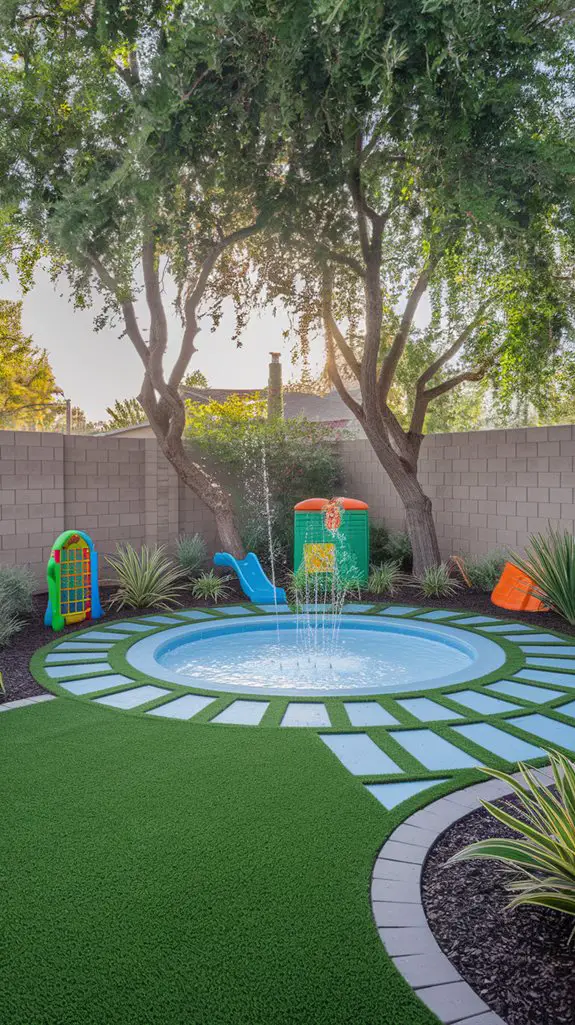
Water play areas offer exceptional developmental benefits while requiring stringent safety protocols to prevent accidents and conserve increasingly precious resources.
Install non-slip surfaces around all water features and maintain adult supervision at all times—even with shallow water depths.
Choose recirculating systems that filter and reuse water rather than continuous-flow options. Rainwater collection barrels can supply your water play zone while teaching children about conservation.
Install automatic shutoff timers to prevent wasteful overflow.
For toddlers, create splash pads with pressure-activated water jets that only operate during active play.
Older children benefit from water tables positioned at appropriate heights with defined boundaries.
Always empty standing water after use to prevent mosquito breeding and bacterial growth.
Lock access to water features when supervision isn’t available using childproof gates or removable control mechanisms.
Incorporating pollinator-friendly plants in your backyard can enhance the overall ecosystem and attract beneficial insects, enriching the play environment for children.
Building a Shaded Nature Exploration Station
Creating a shaded nature exploration station provides children with a protected outdoor space to develop their scientific inquiry skills while minimizing harmful UV exposure.
Install a weather-resistant canopy or plant deciduous trees for natural coverage that adjusts seasonally.
Stock your station with child-safe magnifying glasses, specimen collection containers, and field guides appropriate for your child’s age.
Include a low table where children can examine their discoveries and a small weather station to track environmental changes.
Incorporate local plants that attract butterflies and beneficial insects.
Add a bird feeder positioned for easy viewing but placed to prevent climbing hazards.
Use child-safe, sustainable materials for all components and secure any potential tipping hazards.
Regularly inspect the area for insect nests, sharp objects, and deteriorating materials that could compromise safety while maintaining the integrity of this valuable learning environment. Additionally, consider creating a safe play area that encourages small dogs to explore nature alongside children, fostering a mutual appreciation for the outdoors.
Establishing Boundary Markers for Safe Play Perimeters
Clearly defined boundaries serve as essential safety components in any backyard play area, helping children understand where they can freely explore and where they should stop.
Install physical markers that are both visible and intuitive for young children—colorful garden fencing, painted stones, or low hedges work effectively without creating hazards.
For toddlers, consider double boundary systems: an inner “free zone” surrounded by a supervised “transition zone” before reaching prohibited areas.
Research shows children respond best to consistent visual cues, so use distinctive colors or patterns that don’t blend with surrounding vegetation.
You’ll want to regularly review boundary rules with children and verify markers remain intact after weather events.
For maximum effectiveness, incorporate boundary recognition into playful activities rather than presenting them solely as restrictions. Additionally, creating a designated play zone can significantly enhance the overall safety of play areas, allowing children to engage in activities with minimal risk.
Setting up an Obstacle Course With Safety Features
An obstacle course designed with age-appropriate challenges provides excellent physical development opportunities while incorporating essential safety features.
When creating your course, install shock-absorbing materials like rubber mulch or sand beneath climbing elements and balance beams to minimize fall injuries.
Maintain 3-4 feet of clear space between obstacles to prevent collisions during high-energy play. Select weather-resistant materials that won’t splinter, rust, or deteriorate with exposure.
Regularly inspect all components for structural integrity, removing any protruding nails or loose parts immediately.
For toddlers, keep obstacles under 24 inches tall, while school-aged children can safely navigate 36-48 inch challenges with proper supervision.
Consider installing handrails on elevated sections and using rounded edges throughout the course to protect against impact injuries. Additionally, incorporating fun backyard obstacle courses can enhance children’s engagement and motivation to play outdoors.
Incorporating Sensory-Rich Play Stations for Development
Sensory-rich play stations serve as essential components in backyard environments, stimulating cognitive development while enhancing fine and gross motor skills.
Create a water table with measuring cups and funnels to introduce scientific concepts through splashing exploration. Add a sandbox with buried treasures and various scooping tools to improve dexterity and spatial awareness.
For auditory stimulation, install wind chimes or construct a music wall using safe recycled materials.
Introduce textural variety with a barefoot sensory path featuring sections of smooth stones, soft artificial grass, and rounded wooden discs. Plant aromatic herbs like lavender and mint in child-accessible containers, encouraging smell identification activities. Additionally, incorporating pet-friendly outdoor entertainment elements can enhance the overall experience for your furry friends.
Ensure all stations have appropriate ground padding, are visible from supervision points, and use non-toxic, weather-resistant materials to maintain safety standards while maximizing developmental benefits.
Conclusion
By implementing these seven safe backyard play zone strategies, you’ll create a developmentally appropriate environment where children can explore, learn, and grow with reduced injury risk. Research shows that children who engage in diverse outdoor play develop stronger motor skills and spatial awareness. Eight-year-old Sophia, who struggled with balance issues, showed remarkable improvement after her parents installed a sensory path with varying textures and gradients in their backyard play area.

